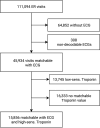Predicting troponin biomarker elevation from electrocardiograms using a deep neural network
- PMID: 39477343
- PMCID: PMC11529765
- DOI: 10.1136/openhrt-2024-002937
Predicting troponin biomarker elevation from electrocardiograms using a deep neural network
Abstract
Background: Elevated troponin levels are a sensitive biomarker for cardiac injury. The quick and reliable prediction of troponin elevation for patients with chest pain from readily available ECGs may pose a valuable time-saving diagnostic tool during decision-making concerning this patient population.
Methods and results: The data used included 15 856 ECGs from patients presenting to the emergency rooms with chest pain or dyspnoea at two centres in Sweden from 2015 to June 2023. All patients had high-sensitivity troponin test results within 6 hours after 12-lead ECG. Both troponin I (TnI) and TnT were used, with biomarker-specific cut-offs and sex-specific cut-offs for TnI. On this dataset, a residual convolutional neural network (ResNet) was trained 10 times, each on a unique split of the data. The final model achieved an average area under the curve for the receiver operating characteristic curve of 0.7717 (95% CI±0.0052), calibration curve analysis revealed a mean slope of 1.243 (95% CI±0.075) and intercept of -0.073 (95% CI±0.034), indicating a good correlation between prediction and ground truth. Post-classification, tuned for F1 score, accuracy was 71.43% (95% CI±1.28), with an F1 score of 0.5642 (95% CI±0.0052) and a negative predictive value of 0.8660 (95% CI±0.0048), respectively. The ResNet displayed comparable or surpassing metrics to prior presented models.
Conclusion: The model exhibited clinically meaningful performance, notably its high negative predictive accuracy. Therefore, clinical use of comparable neural networks in first-line, quick-response triage of patients with chest pain or dyspnoea appears as a valuable option in future medical practice.
Keywords: Acute Coronary Syndrome; Chest Pain; Coronary Artery Disease.
© Author(s) (or their employer(s)) 2024. Re-use permitted under CC BY-NC. No commercial re-use. See rights and permissions. Published by BMJ.
Conflict of interest statement
Competing interests: None declared.
Figures





References
Publication types
MeSH terms
Substances
LinkOut - more resources
Full Text Sources
